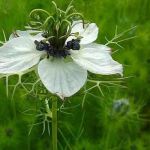| Common Name: |
Kalaunji |
| Other Names: |
Black Cumin, Fennel Flower, Kammun aswad |
| Botanical Name: |
Nigella Sativa |
| Genus: |
Nigella |
| Family: |
Ranunculaceae |
| Native Location: |
SW Asia |
| Cultivation: |
Well-drained soil in sun |
| Propagation: |
By seed sown in situ in autumn or spring. |
| Harvest: |
Seeds are collected when ripe and dried for oil extraction; used whole or ground, or in infusions. |
| Height: |
30cm (12in) |
| Width: |
23cm (9in) |
| Hardiness: |
Hardy |
| Parts Used: |
Seeds, oil |
| Properties: |
An aromatic, laxative herb that stimulates the uterus, increases lactation, benefits the digestion, reduces inflammation, and expels intestinal worms. |
| Medicinal Uses: |
Internally for painful menstruation, postpartum contractions, insufficient lactation, poor appetite, fevers (especially intermittent), and worms (especially in children). Externally for abscesses, hemorrhoids, skin diseases, and orchitis. Contraindicated during pregnancy. |
| Culinary Uses: |
Seeds flavor bread, pastries, curries, meat, chutneys, sauces, vegetable dishes, Middle Eastern fermented foods, and cheeses. |
| Bibliography: |
Encyclopedia of Herbs by Deni Brown Copyright © 1995, 2001 Dorling Kindersley Limited. pp 288-289 |

